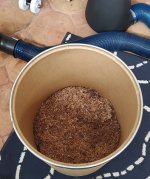Tom the Remodeler
Member
lshj said:Tom Gensmer said:Answering the original question, I have a Hammer A3-41 (the 16" version) with Silent Power cutter head, currently paired with a Oneida Mini Gorilla via 15' of 5" flex hose.
The Mini Gorilla tops out at ~600 cfm @ 2" SP, and easily keeps up with the chips and dust produced by the A3-41, both in planing as well as jointing. There is the occasional chip that gets away, but it's a rarity.
That being said, it's hard to know what cfm your Dust Rite is actually delivering once you put a filter on it, run flex hose to a cyclone, and then more flex hose to your machine. It might not be sufficient.
If you can afford a Hammer, I suggest you put a "real" dust collector on your long-term "To Buy!" list. Your 4" cyclone is going to separate out the chips, but the finest (and most dangerous!) dust particles are still going to get to the Dust Rite, and get spewed back out into your shop. The Mini Gorilla has served my shop well the last six years or so, using a single 15' run of 5" flex and shifting from machine to machine. It has a HEPA filter, which is itself quite easy to clean.
Hope this helps!
Edit: If you need a wall-mount solution, you might be well-served by a Super Cell:https://www.oneida-air.com/dust-collectors/personal-shops/supercell

Thank you. I probably just wait to see how this 1250 CFM dust collector works for the machine. Hopefully it works. I think the 1 micron canister filter is good enough for me, I really like this machine, not noisy, and it's quite clean although I have not use it much yet. The 1250 CFM is 1.5 hp, less than the 2hp Oneida mini but labeled as more CFM? Really don't know how it can get more CFM than the 2hp machine.
I agree that ultimately, you won’t know until your machine arrives and you get a chance to run it with your existing collector.
In terms of specs, different manufacturers use different methods for generating their specs, thus the wide variation. Many collectors are rated at the inlet, with no bag or filter fitted, thus generating really impressive numbers, but setting unrealistic levels that you’ll never actually see in practice. Oneida gets their numbers with a HEPA filter, often at the end of some length of flex hose, yielding less impressive numbers that are nonetheless more representative of real-world performance. I have a Felder RL160 on order, and the testing criteria on is is to fit it with the filter, expose the collector to a proscribed amount of a specific size of dust media for one hour, then collect data…..
I would disagree with your assessment that “there is no way to collect all the ultra fine dust”. This ultra fine dust gets suspended in the air if not collected at the source, in which case you need to filter the shop air. A collector with sufficient performance will have no problem collecting the ultra-fine dust (easier to collect than chips), at which point you need to make sure you have a filter with a sufficient filter efficiency to actually capture the dust, otherwise your “dust collector” is acting as a dust pump, continuing to circulate the fine dust in your shop. I’m not an expert, but I’d be wary of a 1-micron filter, as it won’t filter out the finest dust. Granted, this shouldn’t be a big issue with a jointer/planer, but would be a major concern if you connected to a sander.
Congrats on your upcoming A3-31, it’s a great machine that should give you a lot of great service.

